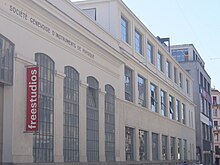Société genevoise d'instruments de physique (SIP)
SIP is a Swiss manufacturer of machining centers for the machining of high-precision components. The company was founded in 1862 as Société genevoise d'instruments de physique for the manufacture of scientific instruments in Geneva . After years of severe crisis, SIP has been part of the Starrag Group in Rorschacherberg since 2006 .
After 1987, the Bâtiment d'art contemporain (BAC) in the Plainpalais district of Geneva was built from two former production buildings . Today it is an urban cultural center that brings together collections and museums of contemporary art under one roof. The most important users are the Musée d'art moderne et contemporain (MAMCO) and the Geneva «Kunsthalle», the Center d'art contemporain Genève (CAC).
Locations
The company produced at the Plainpalais site for 131 years. In 1917, the so-called "Cathedral" was built in Châtelaine as a second location. In 1990 the company moved to the industrial area of Meyrin-Satigny , now the company is based in Vuadens .
Products
- three to five-axis ultra-precision milling centers
- the measuring instruments division was sold in 2005.
history

The Société genevoise d'instruments de physique was founded in 1862 by the two Geneva scholars Auguste de la Rive and Marc Thury to manufacture scientific instruments. Since 1870, hydraulic motors , refrigeration systems , electricity meters and precision rulers have also been manufactured. In 1889 the company received one of twelve platinum-iridium copies of the original meter in Paris.
In 1921, SIP developed the Machine à pointer jig drilling machine, the first machine tool to be mass-produced . It was the first machine of its kind that allowed manufacturing accuracies in the range of thousandths of a millimeter (μm). The company became one of the most respected machine builders in Europe and in 1969 employed around 1,600 people at two locations. The last building in Plainpalais was built in 1958, the Bâtiment D.
In the following years the market situation deteriorated increasingly. Precision in production could increasingly be achieved through the various compensation options of CNC controls . SIP struggled to adapt to changes in the industry. In the 1980s, the buildings in Plainpalais were gradually sold. In 1987, the city of Geneva acquired buildings "C" and "D" to create a space for art exhibitions in the center of the city. As Bâtiment d'art contemporain (BAC) it is now a cultural center whose industrial past has been visibly preserved. The most important user was the Musée d'art moderne et contemporain (MAMCO) which opened there in 1994.
The move to Satigny in 1990 turned out to be far more expensive than planned. Years of global crisis in the machine tool market were the result of the Second Gulf War . Between 1996 and 2005 there were three bankruptcies under different owners. However, since the innovative potential was still there, StarragHeckert bought the SIP in 2006. At that time it only had about forty employees. The company now operates together with Bumotec as Starrag Vuadens SA within the Starrag Group.
literature
- Bénédict Frommel: La SIP, 150 ans de mécanique de précision. Office du patrimoine et des sites, Genève et Société d'instruments de précision SA, Satigny 2012. ISBN 978-2-884-74267-2 .
- Bénédict Frommel: Société genevoise d'instruments de physique (SIP). In: Historical Lexicon of Switzerland . 2012 .

